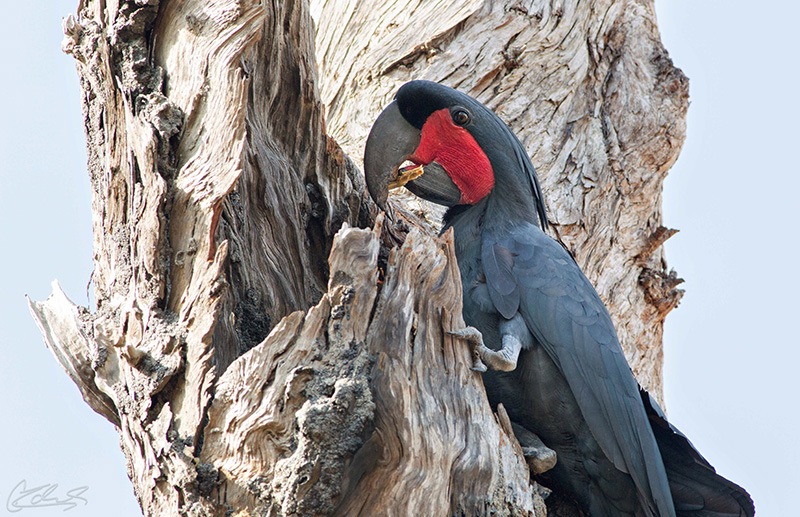

At sunset, pairs leave the group and return to their own territories. Long flights are usually necessary between roosting and feeding sites the group disperses and often meets again at a convenient tree. There they preen, display and interact socially. After a brief foraging trip, a relatively small flock gathers in neutral territory. ‘aim cockatoos roost separately, but call to each other after sunrise. They have been observed flying at one another, trying to knock each other from their perches. Males sometimes exhibit a curious courtship behavior: they hold small sticks in their claws and drum on a hollow log.Ĭockatoos appear to be playful birds. Skilled craftsman The cockatoo sharpens its 5U before feeding. With a cache stored, the bird can push pieces forward with its tongue, split them on the edge of its lower beak and throw them back with a quick toss of its head, to be swallowed. Then it splits the nut in two, storing the halves in its lower mandible. The bird shells and eats nuts efficiently: first, it husks the nut, turning it with its tongue while working the shell off with its beak. The humid rainforests offers the cockatoo an abundance of nuts, fruits, seeds and grubs.

The two birds work together to build a nest by gathering sticks and then shredding and dropping them inside to form a platform.Ī young cockatoo is demanding: both parents work to feed and care for their offspring until six weeks after it leaves the nest. Chicks remain in the safety of the nest for up to 110 days. Pairs mate for life their first task as a mating pair is to find a safe, hollow tree in which to build their nest.Īfter a 30-day incubation, the female usually lays a single egg. It will be two more weeks before the young cockatoo is ready to make its first flight. The chick will stay in the nest for between 100-1 10 days, longer than any other parrot species. Then the chick begins the difficult and exhausting hatching process, which can take 3-4 days it finally emerges without down. Once they choose a site, they’ll use it year after year, constructing a nest by shredding twigs and dropping them into the hollow (left).īoth parents incubate the single egg for about 30 days. Since they pair for life and remain close together throughout the year, courtship rituals are kept to a minimum, with only courtship-feeding the rule.Together the male and female regularly inspect theirterritory for potential nesting sites.The ideal home is a hollow spot in a tree, 10-25′ above the ground. Young palm cockatoos demand constant and attentive care, so adults form strong pair bonds and share parenting duties. In Australia the palm cockatoo is protected and listed in Appendix I of CITES, yet many of these popular birds are smuggled out of the country each year. In New Guinea the bird’s rainforest habitat has been reduced due to logging people also hunt the birds for food and capture them so they can be sold in other countries as pets. The population of palm cockatoos is diminishing. Majestic perch The watchful cockatoo scans the humid rainforest that it calls home. Mating pairs maintain territories with several good nesting trees, which they check on periodically during the year. Palm cockatoos inhabit wetter, warmer climates than most other cockatoo species and usually perch in leafless branches. And Olympic recognition could spur immediate action for palm cockatoo conservation.In Australia, the palm cockatoo makes its home in the eucalyptus forests of the Cape York Peninsula and the rainforests of the Aru Islands in New Guinea, it populates the dense savannah woodlands in the northern and western sections of the island. Whatever: we are talking about a lot of plush toys here, folks. Still, that’s got to be better than everyone conking the person in front of them on the head with ibis-billed projections on their noggins. Which, yes, would probably mean everyone would have to stand up to see.
Palm cockatoo habitat full#
Dr Christina Zdenek, who has been researching the birds for over a decade, asks us to imagine the spectacle (not to mention cacophony) of a stadium full of people with big crested hats on their heads and drumming on the seats. Late last November, in the mind-melting heat of Kutini-Payamu national park on northern Cape York, I watched a pair in full display for half an hour as the male showed off a prospective hollow to its mate. (They are more widespread in New Guinea and the Indonesian Aru Islands, so Birds Queensland is encouraging the government to involve our neighbours in celebrations, using the cockatoo as a tool of soft diplomacy.)įor all the behaviours cited in the first paragraph, palm cockatoos are ridiculously charismatic. So, why the palm cockatoo? Unlike ibis, the cockatoos are unique to far north Queensland in Australia, living in the remote savannahs of Cape York.


 0 kommentar(er)
0 kommentar(er)
